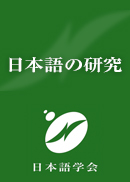Volume 14, Issue 4
Displaying 1-10 of 10 articles from this issue
- |<
- <
- 1
- >
- >|
A Special Issue Dedicated to the Memory of Professor YAMAGUCHI Akiho
-
2018Volume 14Issue 4 Pages 1-2
Published: December 01, 2018
Released on J-STAGE: June 01, 2019
Download PDF (194K) -
2018Volume 14Issue 4 Pages 3-5
Published: December 01, 2018
Released on J-STAGE: June 01, 2019
Download PDF (230K) -
2018Volume 14Issue 4 Pages 6-13
Published: December 01, 2018
Released on J-STAGE: June 01, 2019
Download PDF (309K)
-
2018Volume 14Issue 4 Pages 14-30
Published: December 01, 2018
Released on J-STAGE: June 01, 2019
Download PDF (524K) -
2018Volume 14Issue 4 Pages 31-47
Published: December 01, 2018
Released on J-STAGE: June 01, 2019
Download PDF (414K) -
2018Volume 14Issue 4 Pages 48-64
Published: December 01, 2018
Released on J-STAGE: June 01, 2019
Download PDF (738K)
[Reviews]
-
2018Volume 14Issue 4 Pages 65-72
Published: December 01, 2018
Released on J-STAGE: June 01, 2019
Download PDF (351K) -
2018Volume 14Issue 4 Pages 73-79
Published: December 01, 2018
Released on J-STAGE: June 01, 2019
Download PDF (335K)
«Information for Research Materials»
-
2018Volume 14Issue 4 Pages 80-87
Published: December 01, 2018
Released on J-STAGE: June 01, 2019
Download PDF (974K)
Summary of the May 2018 Symposium
-
2018Volume 14Issue 4 Pages 105-110
Published: December 01, 2018
Released on J-STAGE: June 01, 2019
Download PDF (305K)
- |<
- <
- 1
- >
- >|
